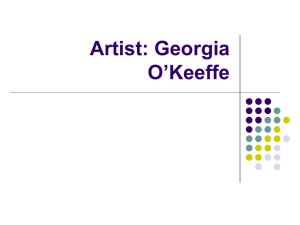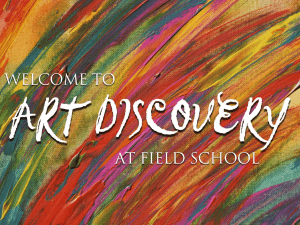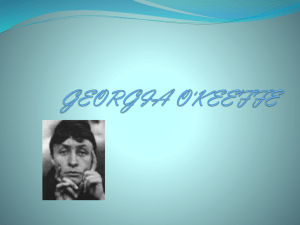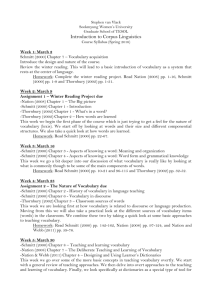Flowers and Skulls: Georgia O`Keeffe and René Girard on the
advertisement
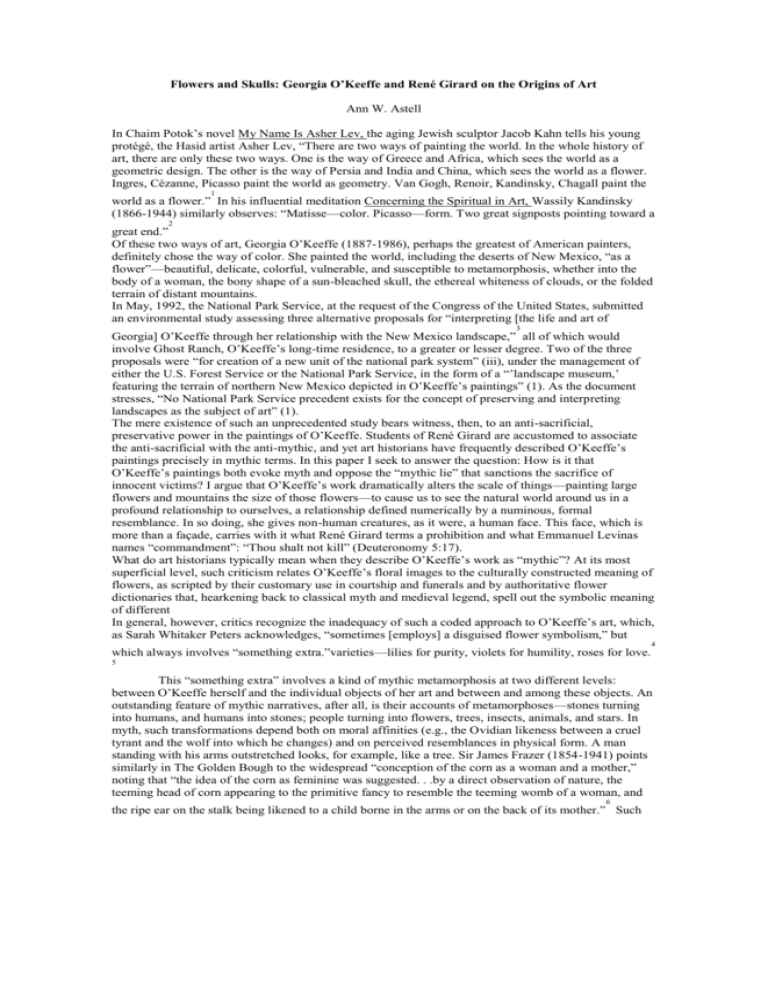
Flowers and Skulls: Georgia O’Keeffe and René Girard on the Origins of Art Ann W. Astell In Chaim Potok’s novel My Name Is Asher Lev, the aging Jewish sculptor Jacob Kahn tells his young protégé, the Hasid artist Asher Lev, “There are two ways of painting the world. In the whole history of art, there are only these two ways. One is the way of Greece and Africa, which sees the world as a geometric design. The other is the way of Persia and India and China, which sees the world as a flower. Ingres, Cézanne, Picasso paint the world as geometry. Van Gogh, Renoir, Kandinsky, Chagall paint the 1 world as a flower.” In his influential meditation Concerning the Spiritual in Art, Wassily Kandinsky (1866-1944) similarly observes: “Matisse—color. Picasso—form. Two great signposts pointing toward a 2 great end.” Of these two ways of art, Georgia O’Keeffe (1887-1986), perhaps the greatest of American painters, definitely chose the way of color. She painted the world, including the deserts of New Mexico, “as a flower”—beautiful, delicate, colorful, vulnerable, and susceptible to metamorphosis, whether into the body of a woman, the bony shape of a sun-bleached skull, the ethereal whiteness of clouds, or the folded terrain of distant mountains. In May, 1992, the National Park Service, at the request of the Congress of the United States, submitted an environmental study assessing three alternative proposals for “interpreting [the life and art of 3 Georgia] O’Keeffe through her relationship with the New Mexico landscape,” all of which would involve Ghost Ranch, O’Keeffe’s long-time residence, to a greater or lesser degree. Two of the three proposals were “for creation of a new unit of the national park system” (iii), under the management of either the U.S. Forest Service or the National Park Service, in the form of a “’landscape museum,’ featuring the terrain of northern New Mexico depicted in O’Keeffe’s paintings” (1). As the document stresses, “No National Park Service precedent exists for the concept of preserving and interpreting landscapes as the subject of art” (1). The mere existence of such an unprecedented study bears witness, then, to an anti-sacrificial, preservative power in the paintings of O’Keeffe. Students of René Girard are accustomed to associate the anti-sacrificial with the anti-mythic, and yet art historians have frequently described O’Keeffe’s paintings precisely in mythic terms. In this paper I seek to answer the question: How is it that O’Keeffe’s paintings both evoke myth and oppose the “mythic lie” that sanctions the sacrifice of innocent victims? I argue that O’Keeffe’s work dramatically alters the scale of things—painting large flowers and mountains the size of those flowers—to cause us to see the natural world around us in a profound relationship to ourselves, a relationship defined numerically by a numinous, formal resemblance. In so doing, she gives non-human creatures, as it were, a human face. This face, which is more than a façade, carries with it what René Girard terms a prohibition and what Emmanuel Levinas names “commandment”: “Thou shalt not kill” (Deuteronomy 5:17). What do art historians typically mean when they describe O’Keeffe’s work as “mythic”? At its most superficial level, such criticism relates O’Keeffe’s floral images to the culturally constructed meaning of flowers, as scripted by their customary use in courtship and funerals and by authoritative flower dictionaries that, hearkening back to classical myth and medieval legend, spell out the symbolic meaning of different In general, however, critics recognize the inadequacy of such a coded approach to O’Keeffe’s art, which, as Sarah Whitaker Peters acknowledges, “sometimes [employs] a disguised flower symbolism,” but which always involves “something extra.”varieties—lilies for purity, violets for humility, roses for love. 4 5 This “something extra” involves a kind of mythic metamorphosis at two different levels: between O’Keeffe herself and the individual objects of her art and between and among these objects. An outstanding feature of mythic narratives, after all, is their accounts of metamorphoses—stones turning into humans, and humans into stones; people turning into flowers, trees, insects, animals, and stars. In myth, such transformations depend both on moral affinities (e.g., the Ovidian likeness between a cruel tyrant and the wolf into which he changes) and on perceived resemblances in physical form. A man standing with his arms outstretched looks, for example, like a tree. Sir James Frazer (1854-1941) points similarly in The Golden Bough to the widespread “conception of the corn as a woman and a mother,” noting that “the idea of the corn as feminine was suggested. . .by a direct observation of nature, the teeming head of corn appearing to the primitive fancy to resemble the teeming womb of a woman, and 6 the ripe ear on the stalk being likened to a child borne in the arms or on the back of its mother.” Such “simple and natural comparisons,” he suggests, are operative everywhere in mythic thinking and serve to 7 explain patterns of ritual substitution. While O’Keeffe, like many artists of her time, was attracted to primitive art precisely because of its cultic significance—its aura; its spiritual, countercultural force in a materialistic age—she understood that the unseen realities, the forms, that the modern artist made visible in the objects of their art, were radically immanent and transcendent precisely through their immanence. A reader of Kandinsky’s Concerning the Spiritual in Art, O’Keeffe was strongly influenced by that work, although, as Peters notes, that influence is seldom “mentioned. . ., 8 and never closely examined,” in part because of O’Keeffe’s reticence on the subject of her sources, in part because Kandinsky’s own artwork and O’Keeffe’s bear little obvious resemblance to each other. O’Keeffe’s halting commentary on her work, however, echoes Kandisky’s text. In an oft-quoted statement, O’Keeffe declares: “Making the unknown known—in terms of one’s medium is all absorbing—if you stop to think of form—as form you are lost—the artists form must be inevitable 9 [sic].” The “inevitability” of form refers to Kandinsky’s notion of the three-fold principle of inner necessity, according to which “(1) Every artist, as a creator, has something in him that demands expression. . . .(2) Every artist, as the child of his time, is impelled to express the spirit of his age. . .[as] dictated by the period and particular country to which the artist belongs; (3) Every artist, as a servant of 10 art, has to help the cause of art.” Practically speaking, “the artist. . .must watch his own inner life and hearken to the demands of inner necessity,” which determine his or her choice of an exterior object or form that resonates with the inner form, “the innate feeling of the artist,” which is the artist’s subjective 11 experience of things. That and only “that is beautiful which is produced by inner necessity, which 12 springs from the soul.” Therefore, as O’Keeffe puts it, “if you stop to think of form as form, you are lost.” Kandinsky similarly damns the mere imitation of exterior form, a copying of the old masters, 13 artists of former times, declaring, “Such imitation resembles the antics of apes.” Why? Because it is merely external, whereas “a work of art consists of two elements, the inner and the outer. The inner is 14 the emotion in the soul of the artist.” When Alfred Stieglitz’s photographs of Georgia O’Keeffe in the nude were exhibited alongside her paintings at the Anderson Galleries in New York in 1921 and 1924, critics were alerted to formal resemblances between the parts and poses of O’Keeffe’s body as captured by Stieglitz’s camera, on the one hand, and the flowing lines in her artwork, on the other. Stieglitz seems, Peters observes, to have wanted “to stress the equality of the paintings and the photographs” and “to foster analogies between the two mediums [sic],” 15 with the result that a reductive, sexual interpretation of O’Keeffe’s work was encouraged from the beginning, to the distress of O’Keeffe, 16 who, according to Benita Eisler, “was 17 never able to acknowledge the sexual element in her art.” The vibrant colors, scale, and relative abstraction of O’Keeffe’s paintings, however, gave them a power that surpassed the appeal of Stieglitz’s black-and-white photographs and that gestured toward a spiritual, rather than a physical, point of reference. As early as 1924, critics sensed (in the words of Henry McBride) that O’Keeffe had “been studying . . . a cala lily. . .and finding in it the secrets of the universe.” 18 Each of her paintings of 19 flowers, fruits, and trees was, as Helen Appleton Read noted, “in a way a portrait of herself,” a selfexpression that countered Stieglitz’s erotic portrayal and use of her. Reviewer Elizabeth Luther Cary observed, “Even though each plate of Stieglitz is a solved mathematical problem, there is a curious suggestion of other problems to come. In every composition of Georgia O’Keeffe, with a greater simplicity and more direct power, there is something more satisfying and complete. . . .Georgia 20 O’Keeffe’s arrangements grow, but complete themselves in their growth.” Analyzed in terms of Girard’s mimetic theory, the relationship between Stieglitz and O’Keeffe was complex. Through his photographs of O’Keeffe’s naked body, Stieglitz imitated in his art his own erotic desire for her, doubling it in a way that it might be literally appropriated by others, the clients of 21 the Anderson Galleries who, desiring his desire for her, would purchase his prints and her paintings. O’Keeffe’s self-portraits in the natural forms of flowers and fruits copied Stieglitz’s portraits of her both 22 by imitating his objectification of her, whom he compared to Nature, and by transferring into the medium of paint what belonged to the technical capacity of photography—the ability to do close-ups, to blur images, etc. In this way, the disciple and protégé came to compete with her older mentor and lover, Stieglitz, desiring herself in art as he had desired her and thus providing a coquettish model for the larger 23 public whom she increasingly claimed as her audience. For his part, Stieglitz instinctively recoiled from what was most original in O’Keeffe and her truest self-portrait, calling her gigantic, colorful flowers “’silly, but lovely,’” and refusing to exhibit all but one of her paintings of nocturnal, New York 24 skyscrapers. Thus the artistic beauty that O’Keeffe had hoped would be a “child” of her loverelationship with Stieglitz and a bond of unity between them was devalued by him, even as it won her ever greater acclaim. Eisler observes: “Georgia’s new giganticism could not have been further removed from Stieglitz’s aesthetic: the cosmos contained in prints smaller than the palm of a hand. The enormous ripples, pleats, and billows of Georgia’s insect-eye view of a flower, along with her modishly ‘fussy’ 25 colors” represented another universe than his. When O’Keeffe narrates the origin of her large flowers, she quietly invokes Kandinsky’s first and second principles of necessity—namely, that the artist must express what is within her (the element of personality) and work as a child of her age (the element of style). She had been looking, she relates, at a “small still life by Fantin-Latour, the great French painter of flowers,” and realized that “the psychological frame of the artist and the physical scale of the work mirrored the intimacy of nineteenthcentury domestic life, irrelevant to the urban sensibility of twentieth-century America,” where “’everything was going so fast’” and “’nobody had time to reflect’.” 26 She observed that Fantin-Latour’s 27 “flower was perfectly beautiful, . . . but so small you could not really appreciate it for itself.” She realized: “Were I to paint the flowers so small, no one would look at them because I was unknown. So I thought I’d make them big like the huge buildings going up. People will be startled—they’ll have to look 28 at them—and they did.” Read superficially, O’Keeffe’s explanation makes the large flowers sound like a publicity stunt, a ballyhoo, to launch the career of an unknown. The word “unknown,” however, has a double-meaning that resonates with that other, previously quoted statement of hers about how the work of art makes “the unknown known,” revealing an invisible reality, a hidden beauty, which is too easily crushed and destroyed by a materialist culture and sexual politics. The smallness of Fantin-Latour’s flowers recalls, after all, the scale of Stieglitz’s plates. Whereas Stieglitz portrayed O’Keeffe by photographing her face, 29 her neck, her exposed breasts, her hands, her naked torso, her legs, her bare feet, O’Keeffe portrayed herself in an indirect way, through a kind of empathy with natural artifacts, whereby she projected herself into the objects of her contemplation. O’Keeffe once told Doris Bry that “when she painted trees, 30 31 she was trees.” More than once she admitted that she had told her life-story in her paintings. Expressing (in Kandinsky’s words) “an inner feeling . . . by nature’s forms,” each of O’Keeffe’s paintings “mysteriously enclosed a whole life of tortures, doubts, of hours of enthusiasm and 32 inspiration.” What Kandinsky writes of Cezanne’s still life paintings applies to O’Keeffe’s flowers: “[She] . . . raised still life to the point where it ceased to be inanimate. [She] painted things as [she] painted human beings, because [she] was endowed with the gift of divining the internal life in 33 everything.” Rachel Fulton has written that the use of flowers in prayer is explicable “because flowers bear a 34 special relationship at once to our bodies—our flesh—and to the work of our imagination.” Pointing to “a long history of [floral] interaction with human beings,” Fulton draws upon the work of Michael Pollan to suggest an evolutionary connection between flowers and humans, whose very existence would not be possible without the development, 65 million years ago, of angiosperms: “Without flowers, we would have no flesh—no warm blood, no energy, no souls. . . .The beauty that we see in flowers is to a large extent an image of ourselves.” 35 Given this reflective quality, she asserts, “the best flowers [for the purpose of meditation] have the shape of a mandala (literally, “circle”).” 36 Scripture tells us that a man 37 blooms “like a flower of the field” (Psalm 102:15). Would it be too much to say that O’Keeffe’s flowers have faces? Working in another medium, Ezra Pound, another student of Kandinsky’s Concerning the Spiritual in Art, famously identified faces with flower petals in his lyric “In a Station of the Metro”: “The apparition of these faces in the crowd; / Petals on a wet, black bough.” In his essay “Vorticism” (1916), Pound refers explicitly to Kandinsky and uses the telling phrase “a language in color” to describe what happened to him after he had felt a “sudden emotion” at the sight of a series of beautiful human faces in a dark, Parisian metro station. Lacking words to describe what he felt, he struggled to convey his emotion until “there came an equation. . .not in speech, but in little splotches of color,” petals in the form of faces, colored to match his inner feeling. 38 These abstracted faces, not unlike O’Keeffe’s floral self-portraits, are expressive of an inner emotion that is capable of moving others; they bespeak a relationship, not only between the artist and nature, but also between humans. The artist can thus be a prophet, a witness, to the beauty of a creation for which humankind is held responsible. Beholding beauty, contemplating it, who dares to touch it, to destroy it? Indeed, the very sight of beauty acts, I would argue, as a kind of prohibition against killing. Using the biblical language of the glory of God to describe the Infinite in the finite, Levinas finds that glory in the face: “The face signifies the Infinite. . . .The face is exposed, menaced, as if inviting us to an act of violence. At the same time, the face is what forbids us to kill.” 39 “There is no prohibition,” Girard 40 writes, “that cannot be related to mimetic conflict.” Not long after the crash on Wall Street and the start of the Great Depression, O’Keeffe began making prolonged stays here in Ghost Ranch and Albiquiu, to paint animal skulls and bones. As Eisler reports, “taken together” with O’Keeffe’s flowers, the bones were interpreted symbolically “as elements in a 41 vanitas: the mortality of earthly desires—eros and thanatos, love and death, or the death of love.” It seems more likely to me that these particular artistic objects appealed to her because they expressed her sense of the reality (and hence the beauty) of things as they are here. In this landscape she found a correlative for the shapes, colors, and emotions that were within her. In O’Keefe’s words, “It fitted to me exactly.” 43 42 If, as Kandinsky writes, “Every serious [art]work resembles in poise the quiet phrase: ‘I am here,’” then perhaps we are not wrong to remember the word of the prophet (1 Kings 3:4), oft-quoted by Levinas: “Here I am!”

